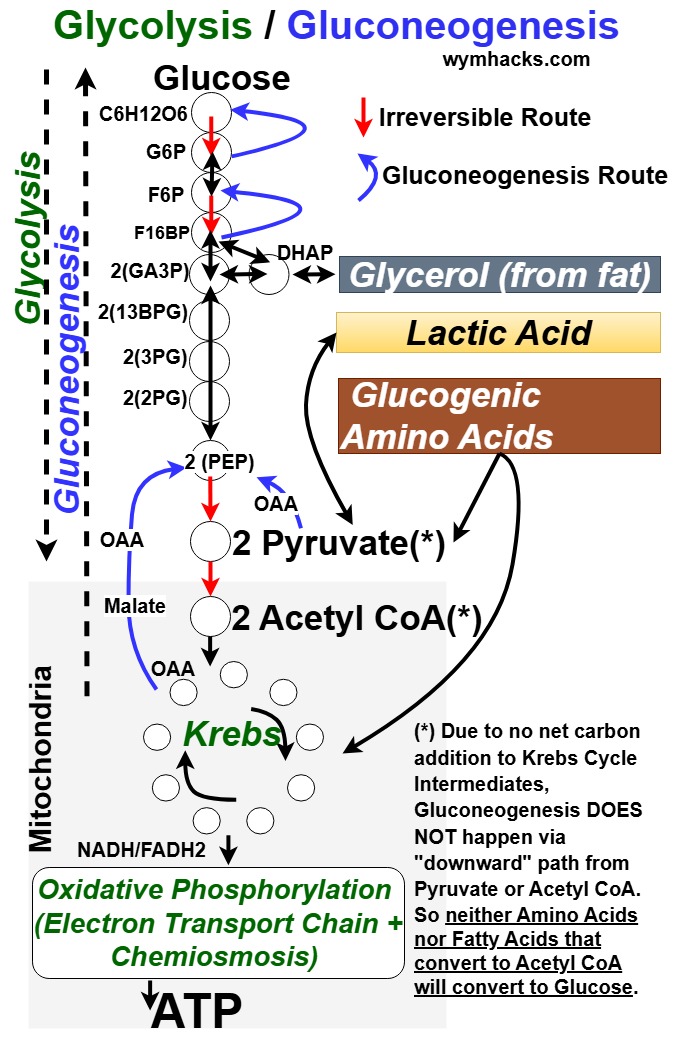Glycolysis / Gluconeogenesis
Glycolysis and Gluconeogenesis Reaction Pathways
Last Update: November 2, 2024
The charts below show the Cellular Respiration reaction pathway with a focus on Glycolysis (the break down of Glucose) and Gluconeogenesis.
Gluconeogenesis is the formation of glucose from non-carbohydrate sources like lactate, glycerol, and glucogenic amino acids (but not from Fatty Acids.)
Gluconeogenesis is, essentially,
- the reverse of_Glycolysis and
- is able to bypass the three irreversible steps of_Glycolysis with the help of unique enzymes.
- These unique paths are highlighted in blue font in the flowcharts below.
Picture Glycolysis and Gluconeogenesis Pathways

Picture_Glycolysis and Gluconeogenesis Pathways – Simplified

I generated the following text from Google Gemeni:
Glycolysis
“Glycolysis is a metabolic pathway that breaks down glucose into pyruvate, generating a small amount of ATP and NADH.
It occurs in the cytoplasm of cells and is a fundamental process for energy production.
During_glycolysis, glucose undergoes a series of enzymatic reactions, including phosphorylation, isomerization, and oxidation, to ultimately yield pyruvate.
This pathway is essential for both aerobic and anaerobic respiration.
Gluconeogenesis
Gluconeogenesis is a metabolic pathway that synthesizes glucose from non-carbohydrate precursors, such as pyruvate, lactate, and amino acids.
It primarily occurs in the liver and kidneys and is crucial for maintaining blood glucose levels, especially during fasting or strenuous exercise.
Gluconeogenesis involves a series of reactions that are largely the reverse of_glycolysis, but with some key differences to overcome the irreversible steps in glycolysis.
This pathway requires energy input in the form of ATP and GTP, and it is tightly regulated to balance with glycolysis and maintain metabolic homeostasis.”
Refer to my Cellular Respiration series , linked below.
- Cellular Respiration (I) Overview
- Cellular Respiration (II) Glycolysis
- Cellular Respiration (III) Pyruvate to Acetyl CoA
- Cellular Respiration (IV) Krebs Cycle
- Cellular Respiration (V) Oxidative Phosphate Addition
Refer to these great references as well.
- Cellular respiration-khanacademy.org
- Cellular respiration introduction-khanacademy.org
- Overview of cellular respiration-khanacademy.org
- Overview of glycolysis-khanacademy.org
- Gluconeogenesis 1, Gluconeogenesis 2 – khanacedymy.org
- Krebs / citric acid cycle-khanacademy.org
- Oxidative phosphorylation and the electron transport chain-khanacademy.org
- Electron transport chain-khanacademy.org
- Oxidative phosphorylation and chemiosmosis-khanacademy.org
- ATP synthase-khanacademy.org
- Calculating ATP produced in cellular respiration-khanacademy.org
Documents
- Introduction to cellular respiration and redox-khanacademy.org
- Steps of cellular respiration-khanacademy.org
- Glycolysis-khanacademy.org
- Pyruvate oxidation-khanacademy.org
- The citric acid cycle-khanacademy.org
- Oxidative phosphorylation-khanacademy.org
- Oxidative Phosphorylation: The major energy provider of the cell-khanacademy.org
- Electron Transport Chain – UC Davis
Disclaimer: The content of this article is intended for general informational and recreational purposes only and is not a substitute for professional “advice”. We are not responsible for your decisions and actions. Refer to our Disclaimer Page.
